
During this year’s Rama Navami, let us go back in history and get a glimpse where Lord Ramachandra performed His pastimes, as recorded in Valmiki Ramayana.
Lord Rama, Sitadevi and Lakshmana In The Forest
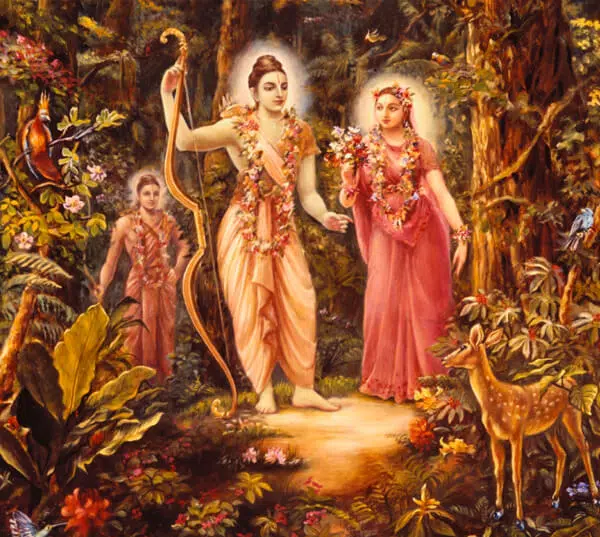 The Supreme Lord descended as Sri Ramachandra in Treta-yuga in order to deliver the pious and to annihilate the miscreants, as well as to re-establish the principles of religion. Lord Ramachandra exemplified the characteristics of an ideal king for maintaining and protecting the highest culture of humanity. His exalted qualities and activities are always sung and relished by His devotees.
The Supreme Lord descended as Sri Ramachandra in Treta-yuga in order to deliver the pious and to annihilate the miscreants, as well as to re-establish the principles of religion. Lord Ramachandra exemplified the characteristics of an ideal king for maintaining and protecting the highest culture of humanity. His exalted qualities and activities are always sung and relished by His devotees.
The great epic Ramayana narrates how Lord Rama was sent to the forest by His father Maharaja Dasharatha. Demonstrating the behavior of an ideal son, the Lord left for the forest obeying the order of His father, just when He was to be coronated as the king of Ayodhya.
The Lord along with His consort Sitadevi and younger brother Lakshmana entered the Dandakaranya forest to be in exile there for fourteen years. During their stay in the forest, Sitadevi was kidnapped by the demon Ravana, the King of Lanka. The Ramayana narrates the journey of Rama to Lanka in search of Sitadevi.
NASA satellite photo: The remains of the Rama Setu
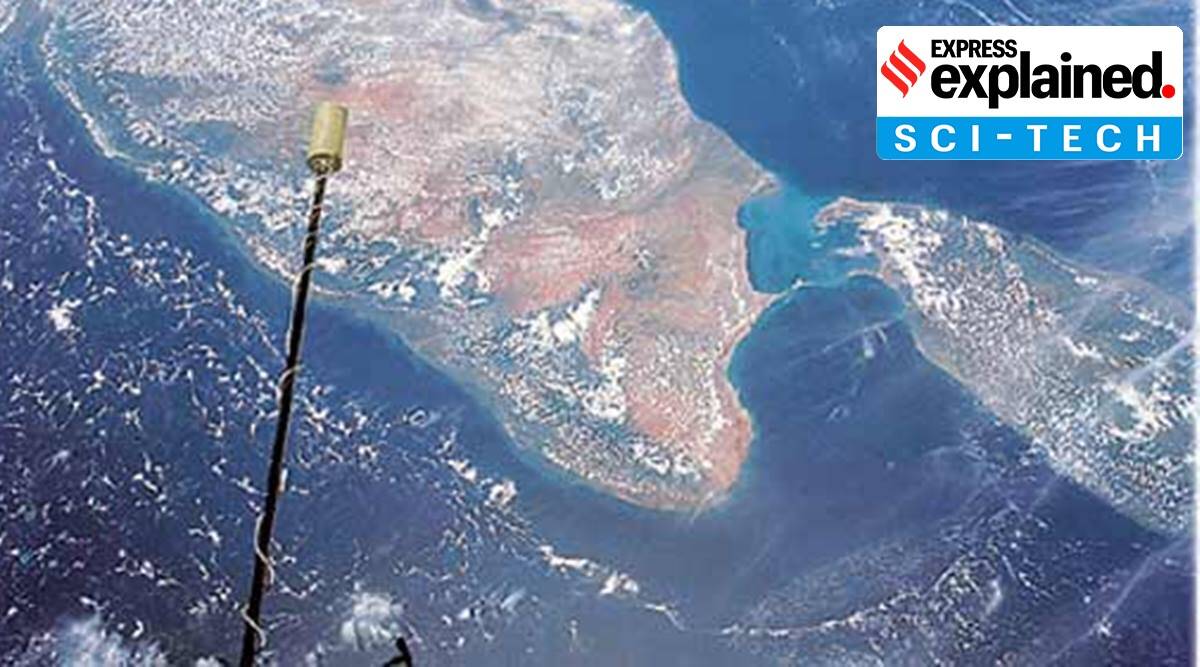 There are hundreds of ancient monuments along the route that Sri Rama had taken from Ayodhya to Lanka and bear testimony to His presence even to this day. A photograph by the US Space Agency shows the remains of the ‘Setu’ (bridge) that He built between India and Sri Lanka. Sri Rama’s temples abound in every nook and corner of not only India but also in the whole of Aryavart of yore, which included Indonesia, Thailand, Cambodia, etc.
There are hundreds of ancient monuments along the route that Sri Rama had taken from Ayodhya to Lanka and bear testimony to His presence even to this day. A photograph by the US Space Agency shows the remains of the ‘Setu’ (bridge) that He built between India and Sri Lanka. Sri Rama’s temples abound in every nook and corner of not only India but also in the whole of Aryavart of yore, which included Indonesia, Thailand, Cambodia, etc.
Several of the events mentioned in the Valmiki Ramayana have been authenticated by recent archaeological findings. His presence dates back to 9323 years as per the astronomical configurations described by Sage Valmiki in his Ramayana.
Iruppu Falls
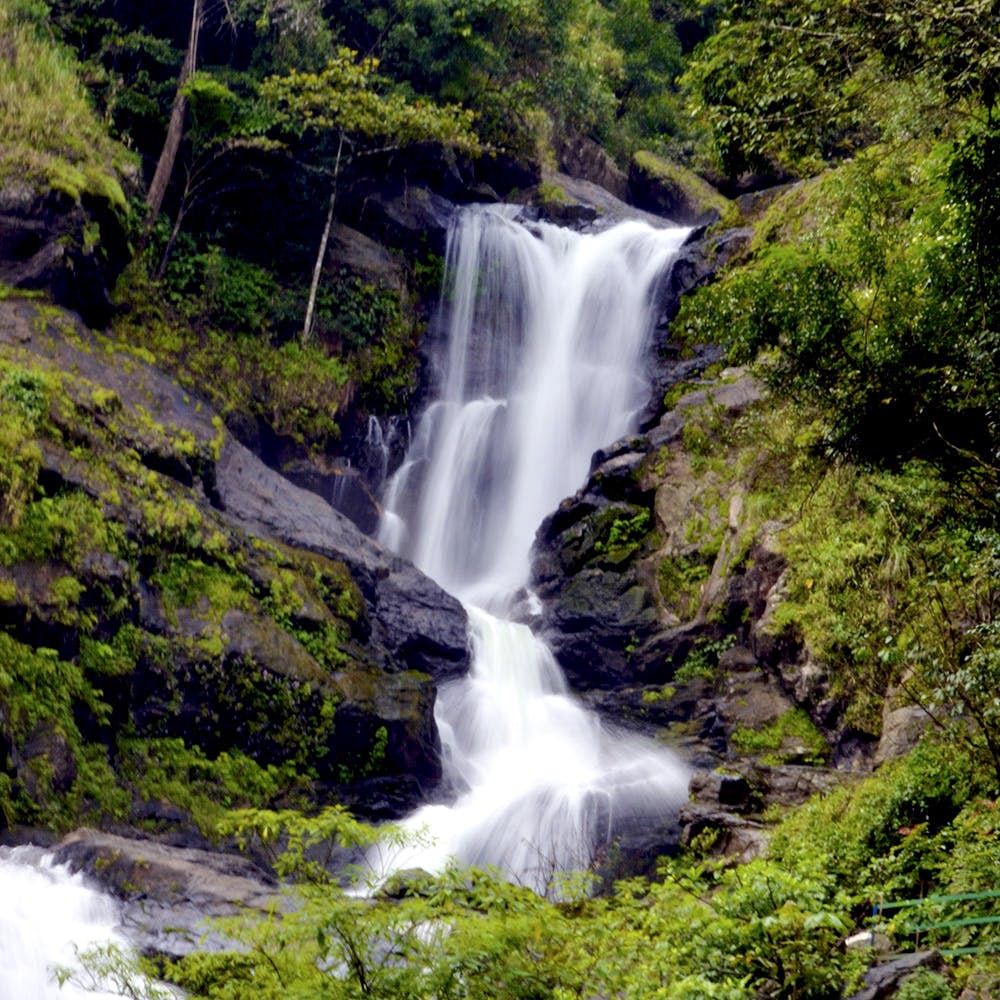 Iruppu is a sacred spot in south Kodagu (Coorg) on the Brahmagiri range of hills. River Lakshmana-tirtha flows nearby. Rama and Lakshmana passed this way while searching for Rama’s consort, Sita. Rama asked Lakshmana to fetch some drinking water for Him. Lakshmana shot an arrow into the Brahmagiri hills and brought into being River Lakshmanatirtha.
Iruppu is a sacred spot in south Kodagu (Coorg) on the Brahmagiri range of hills. River Lakshmana-tirtha flows nearby. Rama and Lakshmana passed this way while searching for Rama’s consort, Sita. Rama asked Lakshmana to fetch some drinking water for Him. Lakshmana shot an arrow into the Brahmagiri hills and brought into being River Lakshmanatirtha.
The river descends perpendicularly into a great cataract known as the Iruppu Falls. This place is believed to possess the power to cleanse one’s sins and is visited by thousands of devotees from far and near on Shivaratri day. There is a temple dedicated to Sri Rama, surrounded by paddy fields, from where it is a climb up to the falls through a forest.
Ramanathapura Temple
At Ramanathapura, on the left bank of the Kaveri river, around 30 km from Kodagu, a huge rock looms out of the river. A Shiva temple stands on it. Known locally as Gogarbham, it is said that Sri Rama worshipped a shivalingam atop the rock to atone for the sin of killing Ravana.
In the village of Kattepura, which lies downstream, an ancient dam slows down the flow of the Kaveri. The dam, Jangamaghatte, was built 900 years ago by Jangamas or ascetics of the Lingayat sect. The stones, which are 1.2 m high, are precisely hewn and stacked. The river seeps slowly, almost wonderingly, through the stones as if Kaveri herself were amazed at this engineering feat achieved by a band of wandering holy men without the aid of modern technology.
The river cascades over a drop of 20 metres at Chunchanakatte (named after Chuncha, a tribal chieftain who built a dam here). The narrow gorge through which the Kaveri tumbles is called Dhanushkoti, after its better-known namesake at the southern tip of India. Sitadevi bathed in the river at this spot (named Siteya Bachchalu or Sita’s Bathing Place) and there is a shrine built by the locals to commemorate the event. On the river bank is a large temple of Kodandarama.
Rameshwaram
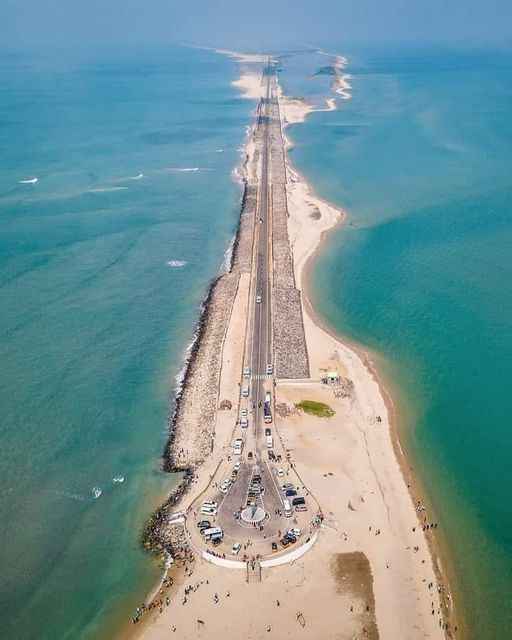 There are four dhamas, or kingdoms of God, which are Badrinath, Jagannath Puri, Rameshwaram and Dwaraka. Rameshwaram is located at the southeastern end of the Indian Peninsula. Rameshwaram is on an island, which is in the shape of a conch shell, in the Gulf of Mannar. The island is sanctified by the footprints of Lord Rama. It is said that Lord Rama bathed at Dhanushkodi, where the Bay of Bengal and the Indian Ocean meet.
There are four dhamas, or kingdoms of God, which are Badrinath, Jagannath Puri, Rameshwaram and Dwaraka. Rameshwaram is located at the southeastern end of the Indian Peninsula. Rameshwaram is on an island, which is in the shape of a conch shell, in the Gulf of Mannar. The island is sanctified by the footprints of Lord Rama. It is said that Lord Rama bathed at Dhanushkodi, where the Bay of Bengal and the Indian Ocean meet.
It is said that the Shiva-linga in the Ramanathaswami temple was installed by Sri Rama on His return to the mainland from the island of Lanka, after killing Ravana. Rama wanted to install a Shiva-linga in Rameshwaram to absolve Himself of the sin of killing Ravana, who was a Brahmin. Rama sent Hanuman to Mount Kailash to get the linga. Since Hanuman was late when the auspicious time for installation neared, Sita made a Shiva-linga out of sand. This linga was then installed by Rama and is known as the Rama-linga, because it was installed by Lord Rama.
At the time Hanuman came with the Shiva-linga from Mount Kailash, he was disappointed to find a linga already installed. Rama told Hanuman that he could remove the linga made by Sita and install the one he brought in its place. Hanuman took hold of the linga with his hands and could not move it. He then wrapped his tail around it and tried to pull the linga out, but it did not move. The linga is said to still have the marks of Hanuman’s tail on it. To pacify Hanuman, Rama had the linga he brought, the Vishwa-linga, installed alongside the Rama-linga. He ordered that puja (worship) be performed first to the Vishwa-linga, which is still being done today.
Gandhamadhana Parvatham
This two-storied temple is on a small hilltop, about 2.5 km northwest of the Ramanathaswami Temple. There is a set of Lord Rama’s footprints on a Chakra here and the small Ramjharoka Temple. There is a good view of the island from here. The place is called Vedaranyam. It is said that Hanuman made his great leap to Lanka from here.
Kothandaramswami Temple
There are Deities of Sri Rama, Sita, Lakshmana, Hanuman and Vibheeshana here. It is said that Vibheeshana, Ravana’s brother, surrendered to Lord Rama at this place. A series of paintings inside the temple tells the story. In 1964, a cyclone wiped out everything in the surrounding area. The only thing left was the temple. It is located about 8 km from the southernmost tip of the island going toward Dhanushkodi.
Dhanushkodi
This is the place where the bay meets the ocean. Pilgrims are supposed to bathe in the small lagoon here called Ratnakara. This is a place to offer sraddha to the ancestors. It is especially auspicious to bathe here in May. Dhanushkodi is about 20 km southeast of Rameshwaram. It is said that Lord Ramachandra destroyed a small bridge with His bow here at the request of Vibheeshana.
Darbha Sayanam and Adi Jagannatha Temple
Darbha Sayanam (Tirupallani, Pullanranyam) is where Sri Rama observed penance, lying on darbha grass here for three days. It is said that Adi Jagannatha appeared before Him, gave Him the weapon called Divya Chapa, and blessed Him with success.
Five km south of Darbha Sayanam at Adi Setu is the Adi Jagannatha Temple. The Deity of Sri Vishnu here is in a reclining posture on Sesha Naga. It is said that King Dasharatha, the father of Rama, came here to pray for a child, when all his wives were childless. Hindu couples still visit this temple to pray for children. The place where Lord Rama built His bridge is not far from here.
It is said that at the coastal town of Devi Patnam (Navapashanam) Lord Rama put nine stones standing upright in the shallow bay. They are supposed to represent the nine planets that He worshiped for success.
Other Places
There are many pastime places connected with the Ramayana in the area. There is a temple near the bridge that you cross to enter Rameshwaram where there is a floating rock. When Lord Rama went to Lanka with the monkey army, they crossed the ocean on a bridge of floating rocks. Near this temple, close to the bridge, are Lakshmana Teertham and Rama Teertham. Lord Rama is said to have bathed in these two tanks. Kodi Teertham is supposed to be a spring that Lord Rama created by shooting an arrow into the ground.
It is said that at Jata Teertham, Sri Rama washed His hair to get rid of any sins that He might have incurred in the battle at Lanka.
Kishkindha
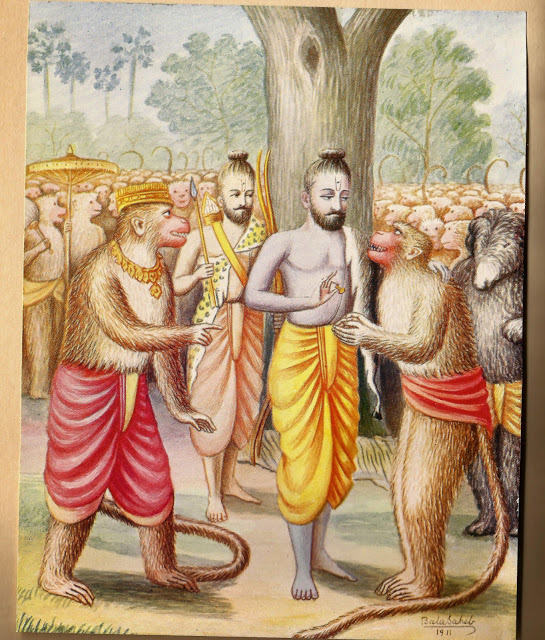 On the way between Virupaksha Temple and Vitthala Temple there is a cave on the bank of the Tungabhadra river where Sugriva is said to have hidden Sita’s jewels for safety. There are marks and streaks on the rocks, which are said to have been made by Sita’s garments.
On the way between Virupaksha Temple and Vitthala Temple there is a cave on the bank of the Tungabhadra river where Sugriva is said to have hidden Sita’s jewels for safety. There are marks and streaks on the rocks, which are said to have been made by Sita’s garments.
The town of Anegundi, about 5 km from Hampi, is situated on the northern bank of the Tungabhadra River. Local people believe this to be the ancient place known as Kishkindha, where Rama met Hanuman and Sugriva. Also nearby Hampi is the Rsimukha Mountain mentioned in the Ramayana.
Kishkindha was ruled by monkey-chiefs – two brothers, Sugriva and Vali. After a quarrel with Vali, Sugriva along with Hanuman were driven out. They then went to stay at Matanga-parvata Hill. While searching for Sita, who had been kidnapped by Ravana, Rama and Lakshmana came south and met Sugriva and Hanuman. Rama killed Vali and restored the kingdom to Sugriva. While Hanuman went to search for Sita, it is said that Rama stayed at Malyavanta Hill, which is on the road to Kampili, about 6 km east of the Virupaksha Temple. There is a Ranganatha Temple here with a large Deity of Lord Rama.
There is a huge mound of scorched ash in the nearby village of Nimbapuram that is said to be the cremated remains of Vali. The birthplace of Hanuman is said to be a little to the northwest.

